Introduction
The Energy Market Regulatory Authority ("EMRA") had opened a draft of the so-called "Unlicensed Generation Regulation"1 (the "Draft Regulation") for public comment on 31 October 2018.
According to an official statement from EMRA, the Draft Regulation intends to consolidate and update the current suite of regulations on unlicensed energy market activities, namely the Regulation on Unlicensed Electricity Generation in the Electricity Market published in the Official Gazette dated 2 October 2013 and numbered 28783 and (ii) the Communiqué on Application of the Regulation on Unlicensed Electricity Generation in the Electricity Market, both of which will be retired once the Draft Regulation is formally issued by EMRA.
The most noteworthy aspects of the Draft Regulation appear to be: (i) the inclusion of electricity storage activities within the scope of unlicensed activities; (ii) the introduction of a settlement system calculated on a monthly basis; (iii) the proposed grandfathering regime for existing roof and facade installations; and (iv) new limitations on the maximum installed power capacity of unlicensed power plants.
Electricity Storage Activities
The Draft Regulation provides that electricity storage activities in the electricity wholesale market and in respect of grid operations will be held exempt from licensing requirements.
The Draft Regulation describes electricity storage activities as the "loading of electricity to energy storage facilities and the supply of electricity stored in such energy storage facilities to the grid".
The Draft Regulation describes electricity storage facilities as "facilities which can permanently store electricity in a limited capacity by transforming it with the help of mechanical, hydraulic, electrochemical, chemical, electrical and thermal energy storing methods, capable of supplying and drawing electricity to and from the grid system on command". However, the Draft Regulation does not provide detailed rules and procedures in respect of the establishment of electricity storage facilities and their connection to the grid. These matters can be expected to be addressed separately, under subordinate regulation and guidance to be issued by EMRA in furtherance to the Draft Regulation.
Monthly settlement
The Draft Regulation introduces a new settlement system that will operate on the basis of monthly calculations, instead of on an hourly-basis as carried out under the existing suite of regulations. The proposed new settlement system, set out in Article 23 of the Draft Regulation, will require each relevant grid operator will determine the excess electricity generated and delivered to the grid on a monthly basis by real persons or legal entities on an unlicensed basis.
Grandfathering regime for roof and facade installations
According to Provisional Article 1 of the Draft Regulation, roof and facade installations which are connected to the same measurement point with their registered consumption facilities and which have received a "Call Letter" after 21 June 2018 and provided they are put into operation by 31 December 2020, will be able to sell their excess generation to the grid in consideration for the retail electricity prices as determined by EMRA. Such roof and facade installations will be eligible to apply for grid connection rights if they have an installed power of maximum of 10kW for residential installations and 1000kW for commercial, industrial, agricultural irrigation and street lightning purposes.
Installations that have received their respective "Call Letters" prior to 21 June 2018 will continue to be entitled to sell their excess electricity generation amounts on the basis of the "feed-in tariffs" applicable for licensed power plants based on renewable energy (i.e. the prices stipulated in Annex – 2 of the Renewable Energy Law numbered 6094).
The status of the roof and facade installations that will commence their commercial operations following 31 December 2020 will be determined at a later stage together with all other power plants benefitting from the "feed-in tariffs".
Installed Power Capacities of Unlicensed Power Plants
The Draft Regulation proposes a substantial reduction to the maximum installed power capacities of licensed of the power plants. According to the Draft Regulation, the installed power of an unlicensed power plant may not exceed the installed power of its registered consumption facility – this limit is a multiple of 30 of the registered consumption facility under the current suite of regulations.
The proposed limitation, if passed in its current form, will narrow the unlicensed power plant market effectively to roof and facade installations. At first sight, this might be considered as a step back for renewable energy. However, considering that unlicensed power plants have caused serious disruption to the market in the past, it could be argued that that ensuring market integrity, which the Draft Regulation appears to be aiming for, may likely provide overriding public benefit in terms of more efficient utilisation of renewable resources.
Conclusion
EMRA proposes to take ambitious strides in the Draft Regulation towards securing frequency control and preventing electricity imbalances through the inclusion of electricity storage activities into the scope of unlicensed generation activities.
The Draft Regulation was closed for public comment on 30 November 2018 and the market is now in a holding pattern to see what changes will be made to the Draft Regulation as a result of market input before it is officially issued by EMRA
Footnotes
1 The long-form title of the Draft Regulation is "Regulation on Unlicensed Activities to be Carried Out in the Energy Market".
The content of this article is intended to provide a general guide to the subject matter. Specialist advice should be sought about your specific circumstances.




